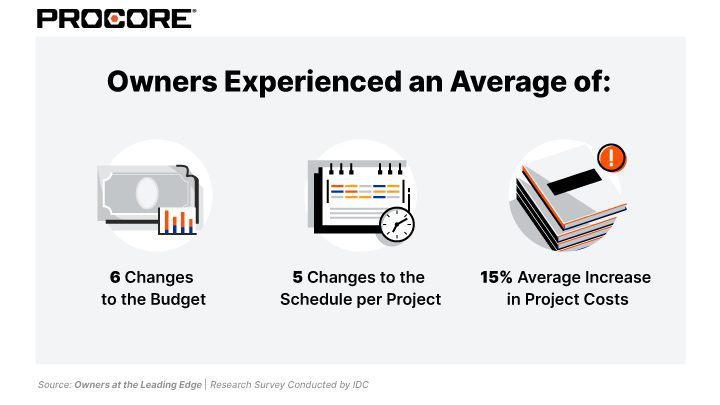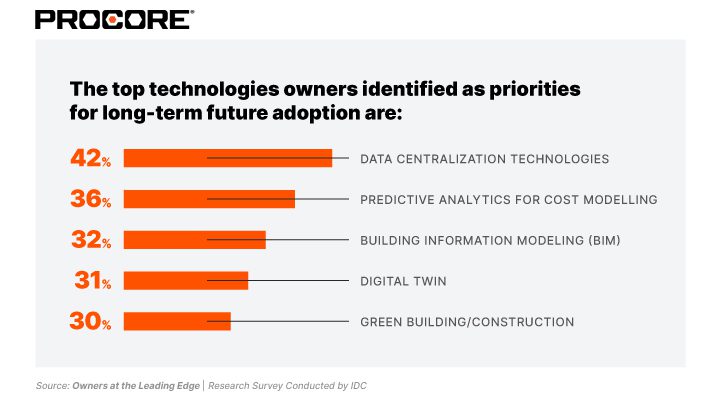Budget and scheduling are perennial challenges in the construction industry, but the uncertainty of the last year has prompted many business owners to rethink their relationship with technology. As we emerge from the worst days of the pandemic, businesses are taking a serious look at how technology can help them navigate the “New Normal.”
In a survey from international research firm IDC, more than 500 construction project owners and developers in the private and public sectors in the U.S. and Canada, were asked where they stand today. The survey, commissioned by Procore, also compares and contrasts the performance of their companies based on where they are in their digital transformation journeys.
The results show a strong correlation between high performance and owners who reported leveraging digital solutions like integrated software and connected platform-based solutions for project management. Survey respondents who said they were heavily reliant on manual or siloed personal productivity solutions were more likely to belong to the low-performing cohort, the survey found.
The survey identified a significant difference between high and low performers based on the respondents’ performance against budget and time estimates. “High-performers” represent the 17% of organizations in the survey who were least often over budget and time estimates, while “low-performers” comprise the 19% of respondents most frequently over time and budget.

Reducing Cost Escalation With Digital Connectivity
Those same paper-based or manual processes are amongst the biggest culprits in blown project budgets. Admittedly, some manual processes involve digital technology, like Excel sheets or Dropbox. However, they’re siloed and completely disconnected from the rest of the organization, providing virtually no help when it comes to tracking or reporting.
“Around 39% of construction projects are still managed with manual or mostly-manual processes. That is gigantic. At a top-line level, this use of manual processes—even extending to paper-based processes—is a big factor behind companies being over budget,” said Warren Shiau, Research Vice President, International Data Corporation (IDC).
When compared to manual processes, the survey found digital solutions that focus on integrated software and a connected platform provide owners a boost in efficiency and productivity that helps them deliver projects on budget and on time.
Across the project lifecycle, there are two identifiable points where lower-performing companies are more likely to employ manual processes:
- During the earlier planning and development stage (drawing management and pre-construction activities, including analysis of earlier planning and development data and how that informs estimating).
- Once project execution is underway (financial controls, change order management, and on-site incident tracking).
Relying on manual processes at key project junctures like these is directly correlated with cost overruns, the survey reveals. As such, being able to digitally connect the people, processes, and data necessary to deliver a project is essential to reduce or even completely eliminate project cost escalation.

Low Performers More Likely To Use Manual Processes
An important difference found between high and low performers was in adopting technology geared toward reporting, controls, analysis, and productivity. The lower-performers were more likely to use ad hoc spreadsheets, outdated software, or even simply pen and paper to manage their projects, particularly for financial controls. By comparison, the higher-performing owners were more likely to have implemented digitization in key areas of their workflow.
The survey findings show key areas where low performers can improve their performance. They include:
- Change Orders: (highest performers 33%; lowest performers 23%)
- Pre-Construction Planning & Estimates/Analysis: (highest performers 22%; lowest performers 14%)
- Specifications: (highest performers 14%; lowest performers 7%)
- Project Conceptualization & Feasibility: (highest performers 17%; lowest performers 10%)
- Incident Tracking & Safety Management: (highest performers 17%; lowest performers 7%)
While changes resulting in project delays are sometimes unavoidable, underlying issues with data, processes, and inefficient use of technology often increase risk and increase the chances of problems appearing in the first place. Digitizing these processes cuts down on that risk significantly.
“If you’re paper-based or siloed in the planning stages, then you lack flexibility later on. So when you need to implement a change, it’s not as easy as when this process is digitized and automated, particularly with drawings and specifications,” said Shiau.
The Importance of Standardization
Technology helps owners achieve more formal, standardized processes and controls than ad hoc methods. Among survey participants, the higher-performers were more likely to have formalized processes in place for things like bidding process compliance, cost reporting, incident tracking and safety management, as well as pre-construction planning, submittals, and bid/tender management.
Nearly 40% of survey respondents said they handle key aspects of project management in an ad hoc or informal way, including everything from completion estimates, to project expenditures, to change orders, to schedule reporting.
Any business that manages itself on an ad hoc basis—especially if their financial controls are ad hoc—is more likely to be late or over budget,” said Shiau.
“Any business that manages itself on an ad hoc basis—especially if their financial controls are ad hoc—is more likely to be late or over budget,” said Shiau.
Lower-performers who haven’t yet prioritized standardization and might not know where to start can get the ball rolling in two main areas.
On the controls side. Specific control areas that involve field-to-office (or cross-functional) communication provide an ability for owners to correctly understand and report on real-time status and accurate data. It’s all possible thanks to standardized, formalized, and well-maintained processes and controls.
On the construction process side. Proper communication, information, and diligence during planning and pre-construction (including bidding and bid management) lead to a project that is more realistic and executable within the planned cost, scope, and schedule, setting owners up for a higher likelihood of successful project delivery.
While schedule and cost overruns are commonplace in construction, there’s an obvious difference between companies stuck in manual project management processes versus ones that embrace digitization.
For additional thoughts and insights from the survey, you can download the “Owners at the Leading Edge: How Construction Project Owners are Using Technology to Achieve On-Time, On-Budget Performance” ebook here. To download the Canadian ebook click here.
Leave a Reply